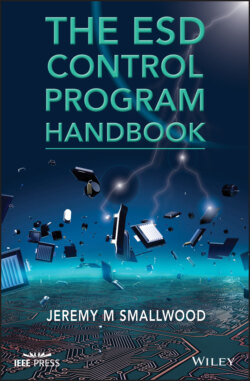Читать книгу The ESD Control Program Handbook - Jeremy M. Smallwood - Страница 67
2.6.2 ESD from Charged Conductive Objects
ОглавлениеWhen a highly conductive (e.g. metal) object is not grounded, it can gain a high voltage either through triboelectrification or through induction in an electrostatic field. If this conductor now touches another grounded conductor or device, an ESD event will occur.
The waveform of real‐world ESD of this type can be highly variable depending on the characteristics of the source and discharge path. Typically, with low resistance source and discharge path materials, a high discharge current reaching tens of amps can occur. The waveform is often oscillatory, with the frequency determined mainly by capacitance and inductance of the source and discharge circuit. The waveform duration may be from a few nanoseconds to hundreds of nanoseconds.
If there is significant resistance in the discharge circuit, the peak ESD current and duration of the discharge are reduced. (For small ESD sources, the effective resistance of the discharge can be significant.) The number of oscillation cycles is also reduced. Eventually with sufficient circuit resistance, a single peak may occur. In practice, discharges from small metal items can look like charged device ESD (Figures 2.14 and 2.15).
If the resistance of the discharge circuit is sufficiently high, the peak ESD current is further reduced, and a unidirectional waveform with fast‐rising edge but long decay may occur.
Figure 2.14 ESD waveform from screwdriver blade charged to +530 V. Charge transferred 0.03 nC.
Figure 2.15 ESD waveform from a160 × 180 mm metal plate charged to 550 V. Charge transferred 2.5 nC.
